Have you been thinking about doing a thru-hike? Already made the decision to do it? Completing a thru-hike like the Appalachian or Pacific Crest Trail from end-to-end can be transformational and life-changing.
Of course, the last thing you want to do is hit the trail unprepared, either mentally or physically. Proper preparation will significantly increase your likelihood of success, improve the quality of your days on the trail and decrease the likelihood of overuse injuries.
Thru-Hiking Mental Preparation
Attitude, in every phase of the thru-hike process, is as important as any physical, logistical or technological element. From the first weeks of planning your pilgrimage, to your first and last days on the trail, maintaining an open mind and a resilient attitude in dealing with obstacles is crucial.
More than anything, a continued focus on taking small steps (often literally) in the direction of the goal, is your most potent weapon in confronting mishap, fear, doubt and weariness.
Thru-Hiking Physical Preparation
The physical preparation needed to cover the millions of steps and hundreds, perhaps thousands, of miles of the trail varies from person to person. Your age, health and current fitness level, among many other things, all factor into how much preparation you will need.
Keep in mind that the early days and weeks of the hike itself will be a significant source of fitness development. However, in general, six months is a reasonable period of time for most people to prepare sufficiently to go the distance. Remember, before you start any workout regime, it's a good idea to consult with your doctor.
Aerobic Training
Hiking frequently and participating in other forms of aerobic fitness like cycling, swimming, running or group fitness classes will not only build a solid aerobic base, it will also build confidence and momentum for your adventure.
Frequency: Pick a minimum number of days per week you will prepare for your thru-hiking goal and stick with it. Consider starting with three to four days of aerobic training per week and, if you have success over the first few weeks, consider adding another day or two of training per week further down the line. A minimum of one full day of rest every week is necessary to allow for mental and physical recovery.
Training volume and progression: It's important to begin with volumes of time or distance in your cardiovascular training that are sufficient to fatigue your body, but that fall well short of exhaustion. By gradually (rather than dramatically) increasing your training volume, you will reduce your risk of overuse injuries.
At the start of your training, you may only hike on flat or rolling terrain without any additional weight. Progress gradually to steeper terrain and as your fitness level develops, begin wearing an empty pack, then a partially weighted pack and eventually the equivalent weight of what you plan to carry on the trail.
Resistance Training
Targeted resistance training is a powerful tool to help your body manage the physical stress of hiking and trail life. Resistance training like lunges, squats and planks will fortify your muscles, connective tissue and bones, and significantly improve your movement efficiency.
Thru-Hiker's Workout
The following sample workout is specifically designed to help the thru-hiker prepare for the trail.
Frequency: The workout can be done before shorter hikes or as a complete workout on certain days. Begin performing this workout two times per week, with at least 48 hours between resistance-training workouts.
Warm-up: Be sure to do a five- to 10-minute warm-up prior to your resistance-training workout. The warm-up should include two to five minutes of light aerobic activity followed by two to five minutes of some dynamic stretching.
Resistance and reps: At the beginning of your training, use a moderate amount of resistance and do two to three sets of 15 repetitions of each exercise, resting about 30 seconds between sets. As you become comfortable with the exercises, gradually increase the resistance by adding additional weight and decrease the number of reps to help you develop more strength.
Squats

- Hold sandbags or dumbbells
- Begin with feet shoulder-width apart; bend your knees and hinge at the hips dropping down as if sitting on a low chair. Ideally, your thighs should be parallel to the ground or lower with the knees above the feet.
- While holding the weight at your sides (dumbbells) or on your chest/over the back (sand bag), keep your chest up and low back firm and push the heels into the ground as you stand back up.
Traveling Lunges
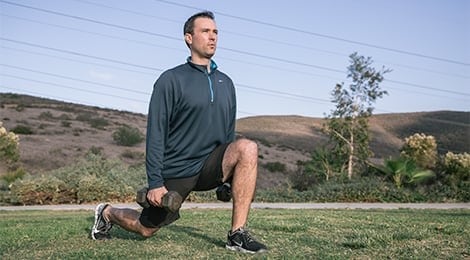
- Hold sandbags or dumbbells, or place your loaded pack on your shoulders
- Step one foot forward and slowly bend both knees to 90 degrees, keeping your knees aligned over the feet (neither turning in our out) and lower the body straight down.
- Maintain a firm lower back and remain broad through the shoulders.
- Press up powerfully from the midfoot and heel of the lead leg.
- Repeat with the opposite leg.
Hip Hinging
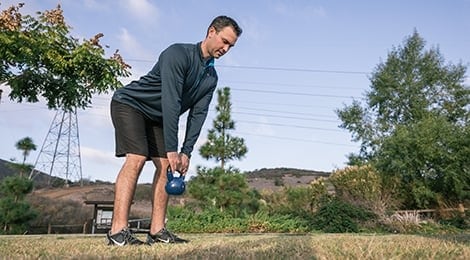
- Use a kettlebell, dumbbell or sandbag
- Begin with feet hip-width apart and with the weight held in the hands in front of the body. Keep your shoulder blades packed in and down throughout the exercise.
- Maintain a broad chest and flat lower back as you hinge forward from the hips; lower your chest to parallel with the ground while keeping a slight bend in the knees.
- Your weight should be pressed firmly into the middle parts of your feet and heels.
Step Ups With Trunk Rotation and Hip Flexion
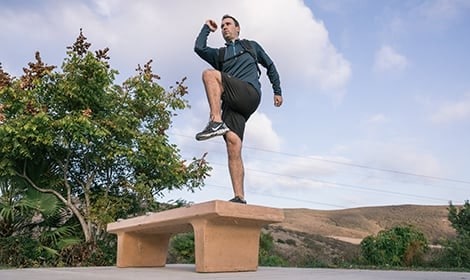
- Press firmly into the lead leg as you step up onto a sturdy bench or box.
- Drive the back leg up and slightly across as you rotate in with the trunk and elbow on the same side as the lead leg.
- Modification: Do this using a dumbbell or sandbag.
Step Back Low Row
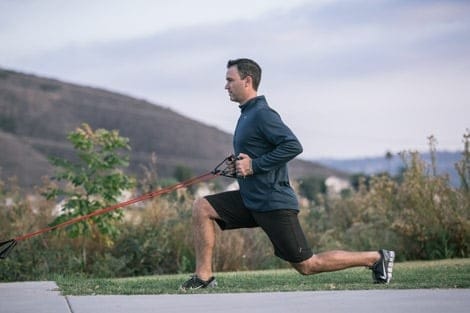
- Use a resistance band
- Begin in a standing position facing the anchor point of the band. Hold both handles and step one foot back, bending both knees into a reverse lunge, with the knees at 90 degrees.
- Keep your core tight as you pull both elbows backward.
- Step back up to the starting position and repeat by stepping back on the other leg.
Side Plank Raises



- Begin on your side with your supporting elbow under your shoulder and your forearm perpendicular to your body. Stack your top foot onto the bottom foot. Raise your hips up into a plank, creating a straight line from your head to feet. Your entire body should stay in alignment throughout the exercise.
- Slowly lower the hips down and then back up to the plank position, pressing into the ground with the bottom forearm.
Push-Up With Single Arm Row
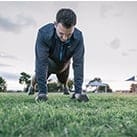

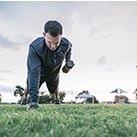
- Use dumbbells
- Begin in a push-up position with hands on dumbbells and feet set wide. Lower the body down in one line and as you push back up, row one elbow back, bringing the dumbbell up toward the rib cage.
- Maintain a plank position throughout the exercise by keeping the body straight from head to toe.
Modification: If you are unable to maintain a stable trunk while on your feet, drop to the knees to complete the exercise.
Essential Static Stretches
After completing your primary aerobic and resistance training sessions, take some time to thoroughly stretch the whole body. If time is short, perform at least one static stretch for each of these major areas: hamstrings, quadriceps, hips and calves. Hold each stretch for 30 seconds to receive the most benefit, and don't forget to breathe while stretching. This commitment to recovery will help prepare your body for your next workout.
The nonprofit American Council on Exercise (ACE) educates, certifies, and represents more than 53,000 fitness professionals, health coaches, and other allied health professionals.
This article is not intended to provide medical advice on personal health issues, which should be obtained directly from a physician.
